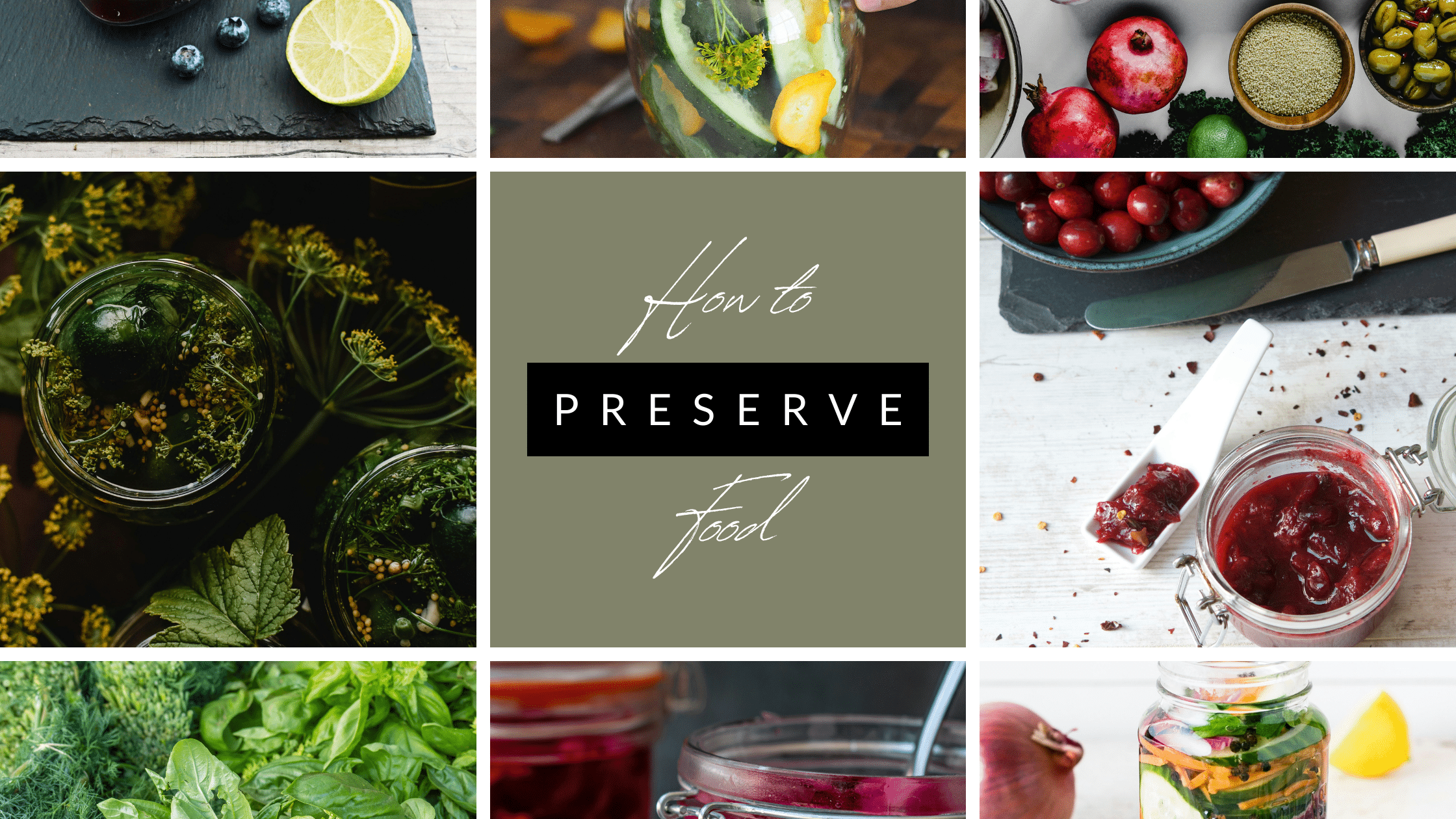If you have ever produced too much in your garden you have probably wondered, “What should I do with all these extra fruit and veggies?” This article contains many great tips for preserving and harvesting your fruits and veggies to be able to enjoy them year-round! The following excerpt is from the book The Regenerative Landscaper: Design and Build Landscapes that Repair the Environment by Erik Ohlsen, with some minor edits for clarity.
Harvesting Leafy Greens
Lettuce (Lactuca sativa)
Harvest the outer leaves of loose heads as needed for fresh eating; the plant will continue to grow. Head lettuce is best left to form tight heads and harvested all at once. Store harvested lettuce in the refrigerator or cold storage and consume within a few days.
Kale (Brassica oleracea var. sabellica)
Harvest the lower leaves of kale by popping them off at the stalk. Work your way up to the top each time you harvest. Our favorite way to eat kale is to pull the leaves off leaf stalks, chop it up, and massage it with salt and olive oil (lemon juice and nutritional yeast are optional additions). Salt wilts the kale and makes it extra tender. Even the kids eat kale this way. To store, add kale to your favorite soups and can or freeze.
Spinach (Spinacia oleracea)
Spinach is best grown in partial shade, the outer leaves harvested when still young and tender. Baby spinach can be added to salad mixes while larger leaves can be cooked into soups, wilted over eggs, or used in specialty dishes like spanakopita. Spinach is one of the few greens that handle freezing well. Pack washed greens into a bag and freeze until ready for use.
Collards (Brassica oleracea var. viridis)
These nutritious greens are highly versatile and take well to being frozen for long-term storage. Harvest the outer leaves when still tender. Steamed collards mixed with your favorite seasoning are a great addition to a meal or add them to soups and other specialty dishes like beans and greens. One of my favorite ways to eat collards is to take a large leaf in the garden and wrap it around other fresh greens and flowers like a burrito wrapping. Try it out! It’s a fun way to consume fresh garden goodies. You can use the large leaves as nutritious wraps for all kinds of foods.
Preserving Root Crops
Carrots (Daucus carota var. sativus)
Carrots come in many shapes, colors, and sizes. Know what you’re planting before you sow those seeds. After you harvest carrots and wash them thoroughly, you can cut them into long strips and put them in a glass container with a little bit of water in it. The water keeps the carrots fresh and crisp instead of wilting as they often do. Keep them in a cool, dark place (refrigerator is best). Make a carrot soup or turn them into crunchy carrot pickles for long-term storage.
Potato (Solanum tuberosum)
Potatoes originate from South America and there are literally thousands of traditional varieties. Some are better for baking while others are better for mashing and still others are better for frying. Mmmm, so many options. Harvest potatoes when the top vines (leaves) have completely died back. This crop takes patience but it’s worth it. They often grow 15:1 meaning that one potato planted will produce 15 new potatoes. Store them in a cool, dry, dark place. Burying them in sawdust is a great way to keep them from sprouting. Whip them up into any of your favorite potato dishes and can or freeze them for long-term storage.
Beets (Beta vulgaris)
Beets are another root crop that has many variations, coming in many colors and patterns and flavors. Beets are delicious steamed and thrown into a salad or turned into borscht—a favorite in my house. Make a large pot of borscht, eat for a few meals, and then can or freeze the rest.
Onion (Allium cepa)
Onions are a staple food in my house as we use them in most of our cooked dishes. Harvest onions when their necks have flopped over. Onions have some of the best storing qualities but they need to be cured to achieve longevity. To cure them, spread them out in a single layer, making sure they don’t touch. This is best done in warm temperatures (75°F–80°F) and a dry breeze is helpful. Leave for a few weeks until the stalks and papery skins are dry. A properly cured globe onion can last up to a year.
Garlic (Allium sativum)
Garlic is best planted in October and harvested in June. Harvest garlic when the stalks turn brown. Remove the roots but leave the stalks. One of the most enjoyable ways to store garlic is to braid the stalks into long bunches of garlic, which are then hung in a dry location. Hang this in your kitchen and harvest garlic directly off the braid as needed.
Preserving Vining & Summer Plants
Tomatoes (Solanum lycopersicum)
Sauce Tomatoes. There are hundreds of tomato varieties but only a few that are best for making sauces. San Marzano, Early Girl, and other red tomato varieties make for great sauces. Harvest tomatoes ripe off the vine and cook them down into sauce. Use it for your favorite pasta and pizza dishes and can or freeze the rest.
Slicing Tomatoes. Slicing tomatoes are of the large variety and can be added to sandwiches or used to make caprese salad. Tomatoes do not store well and need to be eaten fresh within a couple days of harvest. The best storage option for large tomatoes is to chop them up as a base for sauce or salsa, which can then be frozen or canned for later use.
Cherry Tomatoes. Cherry tomatoes are small, bite-sized tomatoes often picked and eaten right in the garden. Use cherry tomatoes in salads, sauces, soups, or roasted tomato dishes. Add to salsa or sauces and freeze or can for preservation.
Cucumbers (Cucumis sativus)
Pickling Cucumbers. Most fresh eating cucumbers make great pickles. That being said, there are few varieties that are specifically grown for pickling. Pickling cucumbers is easily done by fermenting them in a simple salt brine. After a few days of fermentation, they are ready to eat. Preserve pickled cucumbers by canning them for long-term storage or keep in the refrigerator and they will remain good for weeks.
Squashes (Cucurbita)
Winter Squash. Winter squash are varieties that are harvested in the winter once the vine has begun to die back. This means they need to be planted in the late spring and early summer. Most winter squash has thick skin and, once harvested, will stay fresh for many months if kept in a dry location. Squash can be turned into soups or chopped up and preserved by canning or freezing for even longer storage.
Summer Squash. These varieties need to be harvested when they are small and tender. If left on the plant for too long, they will lose flavor and become pithy. Use these for stir-fry, frittata, soup, and roasting. Summer squash can be chopped up and stored in the freezer or made into soups and other favorite dishes for canning and preservation.
Corn (Zea mays)
Sweet Corn. Sweet corn varieties are meant for eating fresh. Sweet corn needs to be harvested when the tassels start to turn brown but before the husks brown at all. If left on the stalk too long, sweet corn will become starchy and lose its flavor. Eat fresh, grill, steam, boil, roast—sweet corn is versatile in its use. Cut the corn from the cob and make into cream of corn soup that can be canned or freeze cut corn as is for later use.
Dent (Flour) Corn. Dent corn (maize) varieties are important food sources for many Indigenous communities of the Americas including Cherokee, Seminole, Hopi, Pueblo, Omaha, Ponca, and others. Maize is considered sacred and has provided the nutritional foundation for many ancient societies. Harvest maize once the entire plant has died back and the corn-cobs are brown and dry. If rains are a threat, corn can be harvested early and dried to completion in the home. Dried dent corn can last years if kept dry. To use this corn, it is best to first follow a traditional nixtamalization (alkaline lime wash) process to soak the corn before grinding. This process dehulls the corn, increases its nutritional value, and makes it easier to grind. Once ready, maize is ground into a fine flour for tortillas and tamales.
Beans (Phaseolus)
Green Beans. Green beans are harvested when the pods are still green and tender. Green beans can be eaten fresh or roasted. One of the best ways to preserve them is to pickle them like you would traditional pickled cucumbers. This is an excellent way to store and eat them.
Dry Beans. Beans are harvested dry and cooked for tacos, soups, and other traditional bean dishes. Wait until the pods are completely brown before harvesting. Remove the dry beans from the pods and they are easily stored as-is for years in a cool, dry, dark place.


